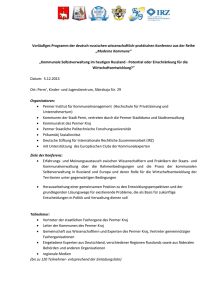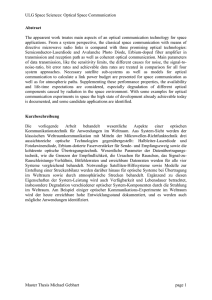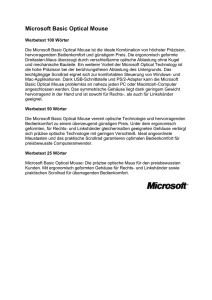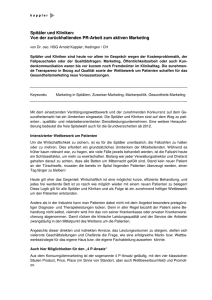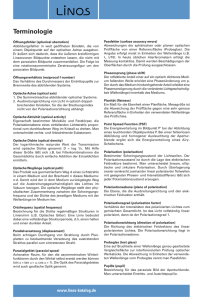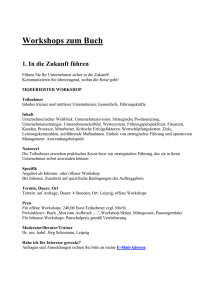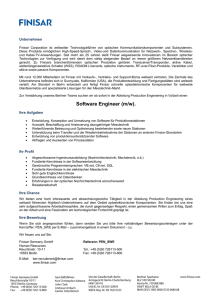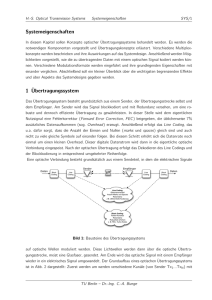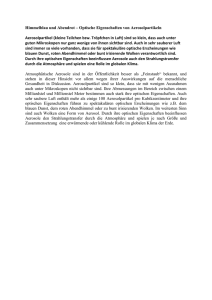9364653d, Optische Sat-Verteilung, Optischer Sender
Werbung
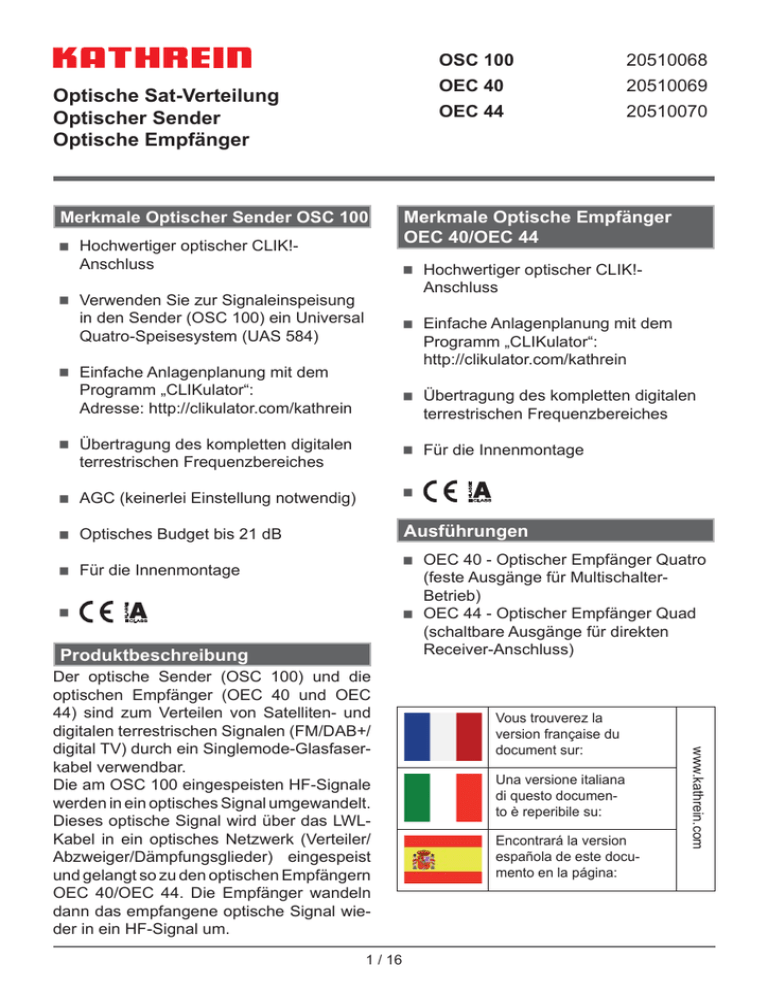
Optische Sat-Verteilung Optischer Sender Optische Empfänger Merkmale Optischer Sender OSC 100 20510068 OEC 40 20510069 OEC 44 20510070 Merkmale Optische Empfänger OEC 40/OEC 44 Hochwertiger optischer CLIK!- Anschluss OSC 100 Hochwertiger optischer CLIK!- Anschluss Verwenden Sie zur Signaleinspeisung in den Sender (OSC 100) ein Universal Quatro-Speisesystem (UAS 584) Einfache Anlagenplanung mit dem Programm „CLIKulator“: http://clikulator.com/kathrein Einfache Anlagenplanung mit dem Programm „CLIKulator“: Adresse: http://clikulator.com/kathrein Übertragung des kompletten digitalen terrestrischen Frequenzbereiches Übertragung des kompletten digitalen Für die Innenmontage terrestrischen Frequenzbereiches AGC (keinerlei Einstellung notwendig) Ausführungen Optisches Budget bis 21 dB OEC 40 - Optischer Empfänger Quatro Für die Innenmontage (feste Ausgänge für MultischalterBetrieb) OEC 44 - Optischer Empfänger Quad (schaltbare Ausgänge für direkten Receiver-Anschluss) Produktbeschreibung 1 / 16 Vous trouverez la version française du document sur: Una versione italiana di questo documento è reperibile su: Encontrará la version española de este documento en la página: www.kathrein.com Der optische Sender (OSC 100) und die optischen Empfänger (OEC 40 und OEC 44) sind zum Verteilen von Satelliten- und digitalen terrestrischen Signalen (FM/DAB+/ digital TV) durch ein Singlemode-Glasfaserkabel verwendbar. Die am OSC 100 eingespeisten HF-Signale werden in ein optisches Signal umgewandelt. Dieses optische Signal wird über das LWLKabel in ein optisches Netzwerk (Verteiler/ Abzweiger/Dämpfungsglieder) eingespeist und gelangt so zu den optischen Empfängern OEC 40/OEC 44. Die Empfänger wandeln dann das empfangene optische Signal wieder in ein HF-Signal um. Der Empfänger OEC40 wandelt das eingehende optische Signal in die vier Ausgänge mit festen Sat-Polarisationsebenen und einen Ausgang für digitale terrestrische Signale um und ermöglicht damit, dass an den Ausgängen direkt ein Multischalter angeschlossen werden kann. Der Empfänger OEC 44 wandelt das eingehende optische Signal in die vier schaltbaren Universal-Ausgänge um und ermöglicht somit, dass das digitale terrestrische- und das SATSignal für vier verschiedene Receiver oder TV-Geräte zur Verfügung steht. Der Sender (OSC 100) ist mit Durchschleifausgängen ausgestattet. Es können mehrere Sender kaskadiert werden. AGC (Automatic Gain Control) automatisch geregelter optischer Ausgangspegel. Dadurch ist keine Einstellung am Sender notwendig. Montage- und Sicherheitshinweise • Die beschriebenen Geräte dienen ausschließlich der Installation von Satelliten-Empfangsanlagen – jegliche anderweitige Nutzung oder die Nichtbeachtung dieses Anwendungshinweises hat den Verlust der Gewährleistung bzw. Garantie zur Folge. • Die Geräte dürfen nur in trockenen Innenräumen montiert werden. Nicht auf oder an leicht entzündlichen Materialien, nicht in der Nähe von oder über Hitzequellen und nicht in Kontakt mit oder in der Nähe von korrosiven Substanzen montieren. • Die Geräte sind mit einer Potenzial-Ausgleichsleitung (Cu, mindestens 4 mm2) zu versehen. • Das Gerät muss von einem qualifizierten Techniker nach den örtlichen Sicherheitsstandards und Vorschriften installiert werden. Das Gerät entspricht der Schutzklasse II und muss daher nicht mit dem Schutzleiter der Netzstromversorgung verbunden werden. • Die Sicherheitsbestimmungen der jeweils aktuellen Normen EN 60728-11 und EN 60065 sind zu beachten. • Die Geräte sind nur für die Wandmontage vorgesehen. Montieren und betreiben Sie die Geräte nicht liegend oder auf dem Kopf stehend. Um das Gerät an der Wand zu befestigen, müssen dafür geeignete Dübel verwendet werden. • HF-Stecker 75 Ω (Serie F) nach EN 61169-24. • Optische Steckverbinder: CLIK! • Nicht benutzte optische Ausgänge sind mit dem Abschluss OTC 1 abzuschließen • Alle nicht belegten koaxialen Anschlüsse sind mit EMK 03 abzuschließen, mit Ausnahme der 4 SAT-Eingänge am OSC 100, die wegen Gleichspannung mit EMK 05 abzuschließen sind. 2 / 16 Sender (OSC 100) und Empfänger (OEC 40 oder OEC 44) können mit vier Schrauben (max Ø: 4,5 mm) an der Wand befestigt werden. Die zur Montage benötigten Schrauben sind nicht im Lieferumfang enthalten. ≥ 5 cm ≥ 5 cm ≥ 5 cm • Für die Geräteentwärmung muss freie Luftzirkulation möglich sein. Überhitzungsgefahr! Nach allen freien Seiten mind. 5 cm Abstand! • Zulässige Umgebungstemperatur: +5 bis +45°C Stromführendes Gerät • Die Versorgungsspannung der Geräte (OSC 100 und OEC 44) beträgt 220-240-V-Wechselspannung und ist bei direkter Berührung lebensbedrohlich. • Bei Arbeiten an der Anlage immer Netzstecker aus der Steckdose ziehen! • Die Installation bzw. Deinstallation der Geräte darf nur in spannungsfreiem Zustand vorgenommen werden • Verwenden Sie nur das mitgelieferte Netzkabel (Adapter). Der Netzstecker muss ohne Schwierigkeiten zugänglich und benutzbar sein. • Das Gerät kann nur durch Ziehen des Netzsteckers vom Netz getrennt werden. • Auf das Netzgerät dürfen keine mit Flüssigkeit gefüllten Gegenstände gestellt werden. • Das Netzgerät darf nicht Tropf- oder Spritzwasser ausgesetzt sein. • Feuchtigkeit und Kondensation können das Gerät beschädigen. 3 / 16 Im Falle einer Kondensation warten Sie bis das Gerät trocken ist bevor Sie es benutzen. • Bei Arbeiten am optischen Verteilnetz sicherstellen, dass die Laser der angeschlossenen Sender durch ziehen der Netzstecker abgeschaltet sind. • Nicht öffnen oder am Gerät manipulieren! Auf keinen Fall dürfen Sie das Innere der optischen Anschlüsse mit bloßem Auge und/oder mit optischen Instrumenten betrachten! Dies kann schwere gesundheitliche Schäden verursachen. Die Laserstrahlung ist für das menschliche Auge nicht sichtbar. Das Gerät darf nur von Personal bedient werden, das die erforderlichen Schulungen über den Umgang mit optischen und elektrischen Geräten erhalten hat und über Sicherheitsanweisungen für den Umgang mit Lasern unterrichtet worden ist. • Bei größerem Durchmesser des Kabel-Innenleiters als 1,2 mm bzw. Grat können die Gerätebuchsen zerstört werden. Max. 2 mm Überstand Durchmesser 0,6-1,2 mm gratfrei Anzugsmoment max. 1,5 Nm (Gefahr des Überdrehens) Potenzialausgleichsklemme Das Gerät muss nach dem Standard EN 60728-11 an den Potenzialausgleich der Antenneninstallation angeschlossen werden. 4 / 16 Anschlüsse optischer Sender OSC 100 1 2 3 4 8 9 5 Netzteil 6 7 10 1 Potenzialausgleichsklemme: 2 SAT-Eingänge: F-Anschlüsse für die vier SAT-ZF-Ebenen (950-2150 MHz) mit LNB-Fernspeisung. 3 Terrestrischer Eingang: F-Anschluss für FM/DAB+/digitale TV-Signale (87,5-862 MHz). 4 Testausgang SAT: F-Anschluss für das SAT-Test-Signal, HH-Polarität (HF-Pegel: 60 dBμV pro Transponder). 5 Testausgang TV: F-Anschluss für das digitale terrestrische Signal 87,5862 MHz (HF-Pegel: 74 dBμV Gesamtleistung). 6 SAT-Ausgänge: F-Anschlüsse für die vier SAT-ZF-Ebenen (950-2150 MHz) für mögliche Kaskaden-Anwendungen zu anderen Sendern oder Multischaltern 7 Terrestrischer Ausgang: F-Anschluss für das FM/DAB+/digitale TV-Signale (87,5-862 MHz). 8 LED Betriebsanzeige: „Ein” (LED leuchtet grün) zeigt an, dass das Gerät eingeschaltet ist. 9 LED Alarm-Laser: Die Alarm-LED zeigt, dass der Laser des Senders nicht einwandfrei arbeitet. 10 Optischer Ausgang: Potenzialausgleich (nach EN 60728-11). CLIK!-Anschluss für die Glasfaserverbindung. 5 / 16 Anschlüsse optischer Empfänger OEC 44 1 Netzteil 4 3 2 Anschlüsse optischer Empfänger OEC 40 1 4 5 2 1 Betriebsanzeige: 2 Potenzialausgleichsklemme: 3 Optischer Eingang: 3 „Ein” (LED leuchtet grün) zeigt an, dass das Gerät eingeschaltet ist. Potenzialausgleich (nach EN 60728-11). CLIK!-Eingang. Wird für die LWL-Verbindung verwendet. Ausgänge (F-Steckverbinder): 4 OEC 44 4 Terrestrisch/ Sat: Vier gemischte Ausgänge für FM/DAB+/digital TV (87,5-862 MHz) und SAT (950-2150 MHz). Terrestrisch: Ein Ausgang für FM/DAB+/digital TV (87,5-862 MHz) Sat: Vier Ausgänge für die vier fest zugeordneten SatPolarisationsebenen VL/VH/HL/HH (950-2150 MHz). OEC 40 5 6 / 16 Systemfunktionen Digitale terrestrische- und SAT-Signale werden zu dem optischen Sender (OSC 100) übermittelt, der die elektrischen Signale in Lichtsignale umwandelt und daher die Verteilung über eine Glasfaser-Infrastruktur über lange Strecken ermöglicht. Für die Aufteilung des optischen Ausgangssignals stehen geeignete Verteiler (OVC xxx) und Abzweiger (OAC xxxx) zur Verfügung. Hinweise zur Dimensionierung des Glasfasersystems Beim Entwerfen eines Lichtleit-Systems ist es wichtig, den optischen Eingangspegel zum Empfänger (OEC 40 oder OEC 44) zu berücksichtigen. Um sicherzustellen, dass das System die erforderlichen Parameter erfüllt, muss in jedem Punkt eine geeignete Dämpfung kalkuliert werden. Die optische Ausgangsleistung vom Sender (OSC 100) ist typ. +7 dBm. Die Eingangspegel der optischen Empfänger (OEC 40 und OEC 44) liegen zwischen -8 dBm und -14 dBm. Damit ergibt sich eine zulässige Dämpfung des optischen Verteilnetzwerkes von 15 bis 21 dB. Der Katalog enthält eine Reihe von optischen Dämpfungsgliedern, Verteilern und Abzweigern mit unterschiedlichen Dämpfungswerten um die Optimierung des Systems zu ermöglichen. Benutzen Sie den Kathrein-Clikulator um das optische Verteilnetzwerk zu dimensionieren (http://clikulator.com/kathrein). Achtung: • Bei direkter Verbindung ohne Verteiler oder Abzweiger zwischen OSC 100 und OEC 40/OEC 44 müssen optische Dämpfungsglieder verwendet werden. Um eine Übersteuerung zu vermeiden, darf die Eingangsleistung am Empfänger -8 dB nicht übersteigen. • Wenn die Qualität der Eingangssignale nicht optimal ist oder wenn ein Vielträger-Signal über ein großes koaxiales Verteilnetz geführt werden soll, sollte das optische Budget verringert werden. • Der Pegelunterschied der Transponder einer SAT-Ebene (VL/VH/HL/ HH) sollte möglichst 4 dB nicht überschreiten. Sollte eine Schräglage der Transponder an den Eingängen des OSC 100 vorhanden und die Pegel hoch genug sein, so kann unter Umständen der passive Entzerrer ERZ 60 verwendet werden (je Band 1 x ERZ 60). Wenn zwischen LNB und OSC 100 eine längere Koaxialstrecke vorhanden ist, so kann mit dem VWS 2500 der Pegel und die Schräglage (je Band) eingestellt werden. Sollten mehrere Sender (OSC 100) kaskadiert werden, so muss zwischen dem dritten und vierten OSC 100 sowie zwischen dem fünften und sechsten OSC 100 ein SAT-Verteilnetzverstärker VWS 2500 zwischengeschaltet werden. Die maximale Kaskade beträgt sieben OSC 100. 7 / 16 Überprüfen Sie vor dem Anschließen an den Empfänger (OEC 40 oder OEC 44) den optischen Pegel des Signales auf der Glasfaser mit einem optischen Leistungsmesser. Wenn das optische Eingangssignal höher als 0 dBm ist, können Schäden am Gerät verursacht werden! Umgang mit optischen Komponenten Allgemeine Hinweise: Der Sender OSC 100 und die beiden Empfänger OEC 40 und OEC 44 besitzen alle einen optischen CLIK!-Anschluss. Die Abzweiger und Verteiler der OAC- und OVC-Serie verfügen über Anschlüsse für CLIK!-Steckverbinder. Kathrein stellt optische Patchkabel mit CLIK!-Steckverbindern unterschiedlicher Länge zum Verbinden der passiven OAC- und OVC-Geräte, sowie geeignete optische Dämpfungsglieder ODC xxx, zur Verfügung. Nicht belegte optische Ausgänge sind unbedingt mit einem optischen Abschluss (OTC 1) abzuschließen. Andernfalls ist die ordnungsgemäße Funktion des optischen Verteilnetzwerkes nicht gegeben. CLIK! Patchkabel CLIK!-LWL-Steckverbinder ODC 2 Raste Schutzkappe Umgang mit Lichtwellenleitern: Installieren und Trennen der LWL-Kabel an den Geräten: 1. Entfernen Sie die Schutzabdeckung vom Anschluss erst, wenn Sie eine optische Verbindung herstellen wollen - ohne die Stirnfläche des Anschlusses zu berühren! 2. Achten Sie auf die Orientierung (Eingang/Ausgang) und drücken Sie den Stecker ein, bis er einklickt (wie in der Anleitung beschrieben) 3. Um das LWL-Kabel wieder zu entfernen, drücken Sie die Raste und ziehen Sie das Kabel heraus. 4. Bewahren Sie die Schutzkappen auf, um die Anschlüsse des Kabels/Gerätes beim Aus- bzw. Umbau wieder zu schützen. 8 / 16 5. Der kleinste zulässige Biegeradius für das LWL-Kabel beträgt 15 mm während der Installation und 10 mm in Betrieb. Ein geringerer Radius erhöht die Dämpfung deutlich und kann zur Beschädigung des LWL-Kabels führen. Deshalb müssen LWL-Kabel immer vorsichtig behandelt werden - besonders während der Installation. Reinigen von optischen Verbindungen: Wenn ein Verbindungsstecker mehrere Male eingesteckt und wieder abgezogen wurde oder ein Fehler aufgetreten ist, kann es erforderlich sein, die optischen Steckerstifte oder Buchsen zu reinigen. Verwenden Sie zur Reinigung das optische Reinigungsset ORS 1 oder das optische Reinigungswerkzeug ORW 1. Eingangspegel optischer Sender OSC 100 Damit die Signale durch die Glasfaser übertragen werden, müssen die HF-Signale folgende Anforderungen erfüllen: TV (DTT/CATV) → DVB-T, Kabelfernsehen Um sicherzustellen, dass die digitalen TV-Signale übertragen und empfangen werden, sollten die digitalen Signale zum Sender auf gleich hohe Pegel eingestellt werden, insbesondere wenn viele digitale Kanäle übertragen werden. Als Anhaltspunkt sollten die Eingangssignale folgende Anforderungen erfüllen: 1. Es können bei QAM64 maximal 40 TV-Kanäle, bei QAM256 maximal 20 TV-Kanäle übertragen werden. Mit Einschränkungen bei der Signalqualität sind bis zu 25 QAM256 TVKanäle möglich. Es sollte möglichst ein TV-Kanalraster im unteren Frequenzbereich bevorzugt werden. 2. Eingangsleistung insgesamt: -19 dBm (90 dBμV) 3. Abhängig von der Anzahl der digitalen TV-Kanäle müssen folgende Pegel am TV-Eingang des optischen Senders (OSC 100) eingehalten werden: Alle Pegelwerte sind pro digitalem TV-Kanal angebeben • 40 TV-Kanäle mit einer Höchstgrenze von 74 dBμV • 20 TV-Kanäle mit einer Höchstgrenze von 77 dBμV • 16 TV-Kanäle mit einer Höchstgrenze von 78 dBμV • 10 TV-Kanäle mit einer Höchstgrenze von 80 dBμV • 8 TV-Kanäle mit einer Höchstgrenze von 81 dBμV Der minimale Eingangspegel (pro digitalem Kanal) muss mindestens 74 dBμV betragen. Wenn die Qualität des digitalen TV-Eingangssignales nicht optimal ist oder wenn die digitalen TV-Kanäle nicht gleich eingepegelt werden können, sollte das System so ausgelegt sein, dass eine optische Dämpfung niedriger als 21 dB erreicht wird um einen korrekten Signalempfang an der Steckdose zu gewährleisten (insbesondere, wenn viele digitale Kanäle übertragen werden). 9 / 16 FM und DAB+ FM- und DAB+-Signalpegel sollten mindestens 10 dB niedriger als die digitalen TV-Signale eingepegelt werden. SAT 1. Eingangspegel: Am OSC 100 muss ein Pegel zwischen 69 und 86 dBμV pro Transponder anliegen, damit die AGC korrekt funktioniert. 2. Pegelunterschied innerhalb einer Sat-Ebene: Der Pegelunterschied der Transponder einer SAT-Ebene (VL/VH/HL/HH) sollte möglichst 4 dB nicht überschreiten. Sollte eine Schräglage der Transponder an den Eingängen des OSC 100 und die Pegel hoch genug sein, so kann unter Umständen der passive Entzerrer ERZ 60 verwendet werden (je Band 1 x ERZ 60). Wenn zwischen LNB und OSC 100 eine längere Koaxialstrecke vorhanden ist, so kann mit dem VWS 2500 der Pegel und die Schräglage (je Band) eingestellt werden. Sollten mehrere Sender (OSC 100) kaskadiert werden, so muss zwischen dem dritten und vierten OSC 100 sowie zwischen dem fünften und sechsten OSC 100, ein SAT-Verteilnetzverstärker VWS 2500 zwischengeschaltet werden. Die maximale Kaskade beträgt sieben OSC 100. Alle nicht belegten koaxialen Anschlüsse sind mit EMK 03 abzuschließen, mit Ausnahme der 4 SAT-Eingänge, die wegen Gleichspannung mit EMK 05 abzuschließen sind. Ebenso sind nicht belegte optische Ausgänge im optischen Verteilnetzwerk mit OTC 1 abzuschließen. Eingangspegel optische Empfänger OEC 40/OEC 44 Um den Empfang durch die OEC 40 oder OEC 44-Empfänger zu gewährleisten, muss der optimale Empfangspegel zwischen -14 dBm und -8 dBm liegen. Dazu muss die Dämpfung des optischen Verteilnetzwerkes bei 15-21 dB liegen. Ausgangspegel optische Empfänger OEC 40/OEC 44 Anm.: Beachten Sie, dass 1 dB Dämpfung in der optischen Übertragungsstrecke 2 dB weniger Signalpegel der elektrischen Strecke (HF) entspricht. Der Ausgangspegel der optischen Empfänger OEC 40 und OEC 44 ist abhängig von der Anzahl der Signale, die durch die Glasfaser und die optische Dämpfung des Abschnitts übertragen werden. Nachfolgend einige Referenzwerte für die Signale an den Empfänger: TV (DTT/CATV) → DVB-T, Kabelfernsehen Die Gesamt-Ausgangsleistung beim OEC 40 beträgt -27 dBm (82 dBμV) und -32 dBm (77 dBμV) beim OEC 44 mit jeweils 21 dB optischer Dämpfung. Das bedeutet, je weniger digitale TV-Kanäle übertragen werden, desto höher ist der Ausgangspegel (pro digitalem Kanal) und die Qualität. 10 / 16 Anzahl der TV-Kanäle HF-Ausgangspegel pro digitalem TV-Kanal Optischer Eingang am Optischer Eingang am Empfänger -8 dBm Empfänger -14 dBm OEC 44 OEC 40 OEC 44 OEC 40 40 73 dBμV 78 dBμV 61 dBμV 66 dBμV 16 77 dBμV 82 dBμV 65 dBμV 70 dBμV 8 80 dBμV 85 dBμV 68 dBμV 73 dBμV 4 83 dBμV 88 dBμV 71 dBμV 76 dBμV 1 89 dBμV 94 dBμV 77 dBμV 82 dBμV Angaben der Ausgangspegel zum OEC 40- oder OEC 44-TV-Signal: Diese Pegel sind Richtwerte für den Idealfall, dass alle digitalen TV-Kanäle am Eingang der Sender gleiche Pegel haben und ohne die Berücksichtigung allfälliger Frequenzgänge. Im konkreten Einzelfall sind die Ausgangspegel der digitalen TV-Kanäle messtechnisch zu ermitteln. SAT Typischer SAT-Signal-Ausgangspegel am OEC 44: • Wenn die Summe aller Transponder einen optischen Pegel von -14 dBm am EmpfängerEingang haben so ergibt sich pro Transponder ein Pegel von 59 dBμV am Ausgang des Empfängers (bei 21 dB optischer Dämpfung und bei Belegung mit 120 Transpondern). • Wenn die Summe aller Transponder einen optischen Pegel von -8 dBm am EmpfängerEingang haben, so ergibt sich pro Tansponder ein Pegel von 71 dBμV am Ausgang des Empfängers (bei 15 dB optischer Dämpfung und bei Belegung mit 120 Transpondern). Der typische SAT-Signalpegel am OEC 40-Ausgang ist: • Transponder mit einem optischen Pegel von -14 dBm am Empfänger-Eingang haben einen Pegel von 67 dBμV am Ausgang des Empfängers (bei 21 dB optischer Dämpfung und bei Belegung mit 120 Transpondern) • Transponder mit einem optischen Pegel von -8 dBm am Empfänger-Eingang haben einen Pegel von 79 dBμV am Ausgang des Empfängers (bei 15 dB optischer Dämpfung und bei Belegung mit 120 Transpondern) • Diese Empfangspegel sind Richtwerte für den Idealfall, dass alle Transponder am Eingang der Sender gleiche Pegel haben und ohne die Berücksichtigung allfälliger Frequenzgänge. Im konkreten Einzelfall sind die Transponder-Ausgangspegel messtechnisch zu ermitteln. FM und DAB+ Die FM- und DAB+-Signalpegel werden gegenüber dem digitalen TV-Signal um mindestens 10 dB abgesenkt. Anm.: Die Signalpegel an den Buchsen müssen den Sollwerten der EN 60728-1-Standard (UKW-Stereo: 50-70 dBμV, DVB-T: 45-74 dBμV, SAT: 47-77 dBμV, digitales Kabelfernsehen: 47-77 dBμV, DAB+: 28-94 dBμV (Band III)) entsprechen. In bestimmten Fällen muss das HF-Ausgangssignal vom Empfänger oder wenn möglich, das optische Eingangssignal durch passive Komponenten, wie z. B. ein optisches Dämpfungsglied, abgeschwächt werden. 11 / 16 Technische Spezifikationen Optischer Sender Bestell-Nr. HF-Eingänge HF-Ausgänge Optischer Ausgang Satelliten-Eingänge Bandbreite Anschluss-Typ Eingang Rückflussdämpfung Einfügungsdämpfung-Stamm HF-Eingangspegel Terrestrischer Eingang Bandbreite Anschluss-Typ Eingang Rückflussdämpfung Summeneingangspegel Testausgänge Bandbreite Anschluss-Typ Ausgang Rückflussdämpfung HF-Ausgangspegel Optischer Ausgang Anschluss-Typ Wellenlänge Optische Ausgangsleistung Optische Rückflussdämpfung Schutzklasse Hauptmerkmale Nennspannungsbereich Leistungsaufnahme LNB-Fernspeisung Betriebstemperatur AGC Regelbereich OSC 100 20510068 5 (4 Sat und 1 digital Terr.) 7 (4 SAT, 1 digital Terr. und 2 Test) CLIK! MHz dB dB dBμV MHz dB dBμV MHz dB dBμV mm dBm dB V~/Hz W mA °C dB LED-Information Abmessungen (B x H x T) Verpackungseinheit/Gewicht mm St./kg 12 / 16 950-2150 F-Buchse 10 2 69-86 87,5-862 F-Buchse 10 90 87,5-862/1100-2150 (HH-Polarität) F-Buchse 10 59 digital TV und SAT (H/H) CLIK! 1310 Typ. +7 > 45 1M 220-240/50-60 15 200 @ 14 V (4 SAT-Anschlüsse) +5 bis +45 Typ. 20 Betriebsanzeige: LED grün Überlastung Laser: LED rot 241 x 238 x 50 1/1,875 Quatro OEC 40 20510069 4 x Sat-ZF und 1 x digital terr. Optische Empfänger Bestell-Nr. HF Ausgänge Optischer Eingang Optischer Anschluss Wellenlänge Optische Rückflussdämpfung Optische Leistung (min-max) HF Ausgänge Bandbreite Anschluss-Typ Rückflussdämpfung HF-Ausgangspegel @ 21 dB optische Dämpfung CLIK! 1310 > 45 -14 bis -8 nm dB dBm MHz 87,5-862/950-2150 F-Buchse 10 dB dBμV 82 (digital TV) Gesamt- 77 (digital TV) Gesamt- Ausgang SAT-Steuerung V~/Hz Betriebsspannung V /mA Leistungsaufnahme Betriebstemperatur LED-Information Abmessungen (B x H x T) Verpackungseinheit/Gewicht 88 (SAT) pegel - Hauptmerkmale Nennspannungsbereich Quad OEC 44 20510070 4 x Sat und digital terrestrisch W °C mm St./kg 14/380 18/330 alle Ausgänge 80 (SAT) pegel 14 V/0 kHz = V/L 18 V/0 kHz = H/L 14 V/22 kHz = V/H 18 V/22 kHz = H/H 220-240/50-60 - 7 +5 bis +45 Betriebsanzeige: LED grün 200 x 140 x 50 250 x 140 x 50 1/0,434 1/0,595 Anwendungsbeispiel Hinweise: • Bei den Antennen, Parabolspiegeln und Multibandverstärkern handelt es sich um typische Beispiele • Die Auswahl der richtigen Empfangsantennen (Terrestrisch und SAT) ist abhängig vom jeweiligen Standort und der jeweiligen Anlagengröße • Die HF-Ausgangspegel an den Empfängern sind abhängig von der Anzahl der übertragenen Signale über die Glasfaser und vom optischen Eingangspegel am Empfänger • Die in den folgenden Ausführungen dargestellten optischen Pegel sind unter Verwendung der typischen Dämpfungswerte für passive Komponenten berechnet • Als Mindestspiegelgröße wird ein CAS 90 empfohlen. Bei größeren Anlagen sollte für die optimale Signalqualität ein CAS 120 eingesetzt werden 13 / 16 • Alle nicht belegten koaxialen Anschlüsse sind mit EMK 03 abzuschließen, mit Ausnahme der 4 SAT-Eingänge des OSC 100, die wegen Gleichspannung mit EMK 05 abzuschließen sind. Ebenso sind nicht belegte optische Ausgänge im optischen Verteilnetzwerk mit dem optischen Abschluss OTC 1 abzuschließen • Die in den optischen Sendern OSC 100 eingebaute AGC regelt unabhängig von der Anzahl der digitalen terrestrischen TV-Kanäle bzw. der Anzahl der übertragenen SAT-Transponder auf einen konstanten optischen Ausgangspegel. Die Pegel der Signale an den HF-Ausgängen der optischen Empfänger OEC 40/OEC 44 sind deshalb abhängig von der Anzahl der übertragenen digitalen TV-Kanäle bzw. SATTransponder • Wenn nach dem OEC 44 noch eine Multischalter montiert werden soll, muss zwischen OEC 44 und dem Multischalter noch die Einspeiseweiche WFS 55 zwischengeschaltet werden. Baumstruktur, aufgeteilt in 8 optische Knoten Wie im Programm „CLIKulator“ (http://clikulator.com/kathrein). 14 / 16 OAC/OVC 5x KAZ 11/12 OAC/OVC Anlagenbeispiel OSC 100 - OEC 44 - OEC 40 (symbolische Darstellung) OTC 1 optischer Abschluss OVC OSC 100 Unterschiedliche Möglichkeiten für den Teilnehmeranschluss OAC/OVC WFS 55 Multischalter *) OSC 100 OFB 5 5x *) OAC/OVC OAC/OVC OEC 44 OEC 44 5x *) OSC 100 ODC xx opt. Dämpfungsglied Multischalter OEC 40 VWS 2500 5x * *) ) OSC 100 5x *) 5x EMK 05 Abschlusswiderstand *) Bitte achten Sie auf die richtige Zuordnung/Verbindung der Aus- und Eingänge zwischen den verschiedenen Komponenten (V low - V low, H low - H low ...) 15 / 16 Elektronische Geräte gehören nicht in den Hausmüll, sondern müssen - gemäß Richtlinie 2002/96/EG DES EUROPÄISCHEN PARLAMENTS UND DES RATES vom 27. Januar 2003 über Elektro- und Elektronik-Altgeräte fachgerecht entsorgt werden. Bitte geben Sie dieses Gerät am Ende seiner Verwendung zur Entsorgung an den dafür vorgesehenen öffentlichen Sammelstellen ab. 936.4653/d/VMWI/0514/DE - Technische Änderungen vorbehalten! Internet: www.kathrein.de KATHREIN-Werke KG • Anton-Kathrein-Straße 1-3 • Postfach 10 04 44 • 83004 Rosenheim • Deutschland • Telefon +49 (0) 8031 184-0 • Fax +49 (0) 8031 184-306 Optical Sat distribution Optical transmitter Optical distribution receiver Premium optical CLIK! connector (UAS 584) to feed in signals to the transmitter (OSC 100) Transmission of the entire digital terrestrial frequency range AGC (no adjustment required) 20510069 OEC 44 20510070 Easy system planning using the “CLIKulator”: Address: http://clikulator.com/kathrein Transmission of the entire digital terrestrial frequency range For indoor installation Optical budget up to 21 dB For indoor installation OEC 40 Premium optical CLIK! connector Easy system planning using the “CLIKulator”: Address: http://clikulator.com/kathrein 20510068 Features Optical distribution receiver OEC 40/OEC 44 Features Optical transmitter OSC 100 Use standard universal quatro LNB OSC 100 Variants OEC 40 - Optical receiver quatro (fixed outputs for multi-switch operation) OEC 44 - Optical receiver quad (switchable outputs for direct connection of receiver) Product description The optical transmitter (OSC 100) and the optical receiver (OEC 40 and OEC 44) can be used to distribute satellite and digital terrestrial signals (FM/ DAB+/digital TV) through a single-mode fibre optic cable. The RF signal fed into the OSC 100 is converted into an optical signal. This optical signal is fed through the fibre optic cable to an optical network (tap/splitter/attenuator) and thus finds the optical receiver OEC 40/OEC 44. The receivers will then convert the received optical signal back into an RF signal. The OEC 40 receiver converts the incoming optical signal in the four fixed-satellite outputs polarisation planes and an output for digital terrestrial signals and thus allows direct connection of a multi-switch on the outputs. The receiver OEC 44 converts the incoming optical signal into the four universal switchable outputs thus allowing the digital terrestrial and SAT signals to be made available for four different receivers or TV sets. 1 / 16 The transmitter (OSC 100) is equipped with loop-through outputs. Several transmitters are cascaded. AGC (Automatic Gain Control) provides for automatically controlled optical output level. Therefore, no adjustment is required on the transmitter. Installation and safety instructions • The equipment described is designed solely for installation in satellite receiver systems. Any other use or failure to comply with these instructions will void the warranty or guarantee. • The equipment may only be installed in dry areas indoors. Do not install on or against highly combustible materials, near or over heat sources or in contact with/near corrosive substances. • The units must be connected to the equipotential bonding rail (Cu, minimally 4 mm2). • The unit must be installed by qualified personnel in compliance with the local security standards and regulations. The unit complies to protection class II and thus need not be connected to the protective earthing of the mains supply. • The safety regulations set out in the current EN 60728-11 and EN 60065 standards must be complied with. • The units are solely designed for on-wall installation. Do not install the device lying flat or on its top, or operate it in this position. Suitable rawlplugs must be used to fix the unit to the wall. • Connectors: RF connectors 75 Ω (series F) according to EN 61169-24. • Optical connectors: CLIK! • Unused optical outputs are to be terminated with OTC 1 • All unused F-type connectors must be terminated with EMK 03, with the exception of the 4 SAT inputs of OSC 100, which due to DC voltage must be terminated with EMK 05. 2 / 16 Transmitter (OSC 100) and distribution receiver (OEC 40 oder OEC 44) can be fixed to the wall using four screws (max Ø: 4.5 mm). The required screws for installation are not included in the scope of delivery. ≥ 5 cm ≥ 5 cm ≥ 5 cm • Free circulation of air must be possible to discharge the heat emitted by the unit. Danger of overheating! Clearance all round at least 5 cm! • Permissible ambient temperature: +5 to +45°C Current-carrying device • The supply voltage of the units (OSC 100 and OEC 44) is 220-240 VAC which can be fatal if touched directly. • When working on the system always unplug the power supply unit from the wall socket! • The units may only be installed and deinstalled in the voltage-free condition • Only use the supplied power cable (adapter). The mains plug must be easily accessible and operable. • The only reliable method of disconnecting the unit from the mains is to unplug it. • No liquid-filled items may be placed on top of the power supply unit. • The power supply unit must not be exposed to dripping or splashing water. • Humidity and condensation may damage the unit. In case of condensation, please wait until the device is dry prior to operation. • When performing work on the optical distribution network, make sure that 3 / 16 the lasers of the connected transmitter have been switched off by disconnecting the mains plug. • Do not open or tamper with the device! Under no circumstances should you look inside the optical connectors either with the naked eye and/or optical instruments! This can prove seriously harmful to your health. Laser radiation is invisible to the human eye. The unit may only be operated by personnel who have received the necessary training in handling optical and electrical devices and has been instructed in the safety rules for handling lasers. • An inner cable conductor diameter greater than 1.2 mm, or the presence of burrs may damage the sockets on the unit. Max. 2 mm excess length Diameter 0.6-1.2 mm free of burrs Tightening torque 1.5 Nm Equipotential bonding terminal The equipotential bonding of the device must be connected as per EN 60728-11 antenna installation guidelines. 4 / 16 Connectors optical transmitter OSC 100 1 2 3 4 8 9 5 Power supply unit 6 7 10 1 Equipotential bonding terminal: Equipotential bonding (as per EN 60728-11). 2 SAT inputs: F-type connectors for the four Sat-IF polarities (950-2,150 MHz) with LNB remote feeding. 3 Terrestrial input: F-type connector for FM/DAB+/digital TV signals (87.5-862 MHz). 4 Test output SAT: F-type connector for the SAT test signal, HH polarity (RF level: 60 dBμV per transponder). 5 Test output TV: F-type connector for the digital terrestrial signal 87.5-862 MHz (RF level: 74 dBμV total power). 6 SAT outputs: F-type connectors for the four Sat-IF polarities (950-2,150 MHz) for cascade applications to other transmitters or multi-switches. 7 Terrestrial output: F-type connector for the FM/DAB+/digital TV signals (87.5-862 MHz). 8 LED operational display: “On” (LED lights up green) shows that the device is switched on. 9 LED alarm laser: The alarm LED shows that the transmitter’s laser is not functioning properly. 10 Optical output: CLIK! connector for optical fibre connection. 5 / 16 Connections optical receiver OEC 44 1 Power supply unit 4 3 2 Connectors optical receiver OEC 40 1 4 5 2 1 Operational display: 2 Equipotential bonding terminal: 3 Optical input: 3 “On” (LED lights up green) shows that the device is switched on. Equipotential bonding (as per EN 60728-11). Clik! input. Used for optical fibre connection. Outputs (F-type connectors): 4 OEC 44 4 5 OEC 40 Terrestrial/ Sat: Four combined outputs for FM/DAB+/digital TV (87.5-862 MHz) and SAT (950-2,150 MHz). Terrestrial: One output for FM/DAB+/digital TV (87.5-862 MHz). Sat: Four outputs for the fixed assigned Sat polarities VL/VH/HL/HH (950-2,150 MHz). 6 / 16 System functions Digital terrestrial and satellite signals are fed to the optical transmitter (OSC 100) which converts the electrical signals into optical signals, thus allowing distribution over long paths using a fibre-optic infrastructure. Suitable splitters (OVC xxx) and taps (OAC xxxx) are available for distribution of the optical output signal. Notes on planning the fibre optic system When designing a fibre optic system, it is important to consider the optical input levels to the receiver (OEC 40 or OEC 44). To ensure that the system fulfils the required parameters, appropriate attenuation must be calculated at each point. The optical output power from the transmitter (OSC 100) is typically +7 dBm. The input level of the optical receiver (OEC 40 and OEC 44) lies between -8 dBm and -14 dBm. This therefore provides an allowable attenuation of the optical network of 15 to 21 dB. The catalogue has a whole range of optical attenuators and taps/splitters which have different attenuation values and enable the optimisation of the system. Please make use of the Kathrein CLIKulator to plan and adjust your optical distribution network. Attention: • If directly connected without splitters or taps, attenuators must be used between the OSC 100 and OEC 40/44. To avoid overload, the input power on the receiver must not surpass -8 dB. • If the quality of an input signal is not optimal or if a multi-carrier signal must be distributed over a large coaxial distribution network, the optical budget should be decreased. • The level difference of a satellite transponder polarity (VL/VH/HL/HH) should not exceed 4 dB. If the transponders have a gain slope on the inputs of the OSC 100 and the level is high enough, in certain circumstances you can use the passive equalizer ERZ 60 to adjust the level (use one ERZ 60 for each satellite polarisation). If a long coaxial cable is used between the LNB and the OSC 100, you can adjust the level and the gain slope (for each satellite polarisation) with the VWS 2500. If several transmitters (OSC 100) are cascaded, a VWS 2500 satellite distribution amplifier must be connected between the third and the fourth OSC 100 and also between the fifth and sixth in the cascade. The maximum quantity is seven in the OSC 100 cascade. Before connecting to the receiver (OEC 40 or OEC 44), check the optical level of the signal on the optical fibre using an optical power meter. If the optical input signal is higher than 0 dBm, damage may be done to the device! 7 / 16 Handling components General notes: The OSC 100 transmitter and the receivers OEC 40 and OEC 44 are all fitted with an optical CLIK! connector. The taps and splitters of the OAC and OVC series are equipped with connections for CLIK! connectors (male). Kathrein provides optical patch cables with CLIK! connectors in various lengths to connect passive OAC and OVC units as well as the suitable optical connectors ODC xxx. Unused coaxial outputs must be terminated with an optical termination (OTC 1) without fail. Otherwise, the proper functioning of the optical distribution network cannot be guaranteed. CLIK! Patch cable CLIK! Optical fibre connector ODC 2 Latch lock Protective cap When dealing with optical waveguides: Installation and disconnection of the fibre optic cable to the equipment: 1. Only remove the protective cover from the connection if you want to create a new optical link - Do not touch the front face of the connector! 2. Pay attention to the orientation (input / output) and push the connector in until it clicks (as described in the instructions) 3. Removal of the fibre optic cable is done by pressing the latch lock and pulling the cable out. 4. Save the protective caps to protect the connectors of the cables/devices when removing or remodelling. 5. The minimum allowed bend radius for the fibre optic cable is 15 mm during the installation and 10 mm during use. A smaller radius significantly increases the attenuation and may cause damage to the fibre optic cable. Fibre optic cable must always be handled carefully - especially during installation. Cleaning optical connectors: If an optical connector (male) has been repeatedly inserted and unplugged or if failure occurs, it may be necessary to clean the optical connector pins or sockets. 8 / 16 For cleaning purposes please use the optical cleaning set ORS 1 or the optical cleaning tool ORW 1. Input level of the optical transmitter OSC 100 To ensure that the signals are transmitted through the fibre optic cables, the RF signals must meet the following requirements: TV (DTT/CATV) → DVB-T, Cable TV To ensure that the digital television signals are transmitted and received, the digital signals to the transmitter should be set to the same high level, especially when multiple digital channels are transmitted. As a guide, the input signals should meet the following requirements: 1. With QAM64 a maximum of 40 TV channels can be transmitted, with QAM256 a maximum of 20 TV channels. With limitations on signal quality, up to 25 QAM256 TV channels can be transmitted. Wherever possible a TV channel grid in the lower frequency range should be preferred. 2. Total input power: -19 dBm (90 dBμV) 3. Depending on the number of digital TV channels, the following levels must be met at the optical transmitter‘s (OSC 100) TV input: All levels are stated per digital TV channel • 40 TV channels with a maximum of 74 dBμV • 20 TV channels with a maximum of 77 dBμV • 16 TV channels with a maximum of 78 dBμV • 10 TV channels with a maximum of 80 dBμV • 8 TV channels with a maximum of 81 dBμV The minimum input level (per digital channel) should be at least 74 dBμV. If the quality of the TV input signal is not optimal or when the digital TV channels cannot be equally levelled, the system should be adapted so that the optical attenuation of less than 21 dB is reached to ensure correct signal reception at the outlet (especially when many digital channels are transmitted). FM and DAB+ FM and DAB+ signal level should be at least 10 dB lower than the digital TV signals. SAT 1. Input level: At OSC 100 there must be a level of 69 and 86 dBμV per transponder, so that the AGC functions properly. 2. Differing levels within a satellite level: The level difference of a satellite transponder level (VL/VH/HL/HH) should not exceed 4 dB. If the transponders have a gain slope on the inputs of the OSC 100 and the level is high enough, in certain circumstances you can 9 / 16 use the passive equalizer ERZ 60 to adjust the level (use one ERZ 60 for each satellite polarisation). If a long coaxial cable is used between the LNB and the OSC 100, you can adjust the level and the gain slope (for each satellite polarisation) with the VWS 2500. If several transmitters (OSC 100) are cascaded, a VWS 2500 satellite distribution amplifier must be connected between the third and the fourth OSC 100 and also between the fifth and sixth in the cascade. The maximum quantity is seven in the OSC 100 cascade. All unused F-type connectors must be terminated with EMK 03, with exception of the 4 SAT-inputs of the OSC 100, which due to DC voltage must be terminated with EMK 05. All unused optical connectors of the optical network must also be terminated with the OTC 1. Input level of the optical receivers OEC 40/OEC 44 To ensure reception using the OEC 40 or OEC 44 receiver, the optimal level must lie between -14 dBm and -8 dBm. Therefore the attenuation of the distribution system should lie between 15-21 dB. Output level optical receiver OEC 40/OEC 44 Note: Please note that 1 dB of attenuation in the optical transmission path corresponds to 2 dB less signal level in the electrical path (RF). The output level of the optical receiver OEC 40 and OEC 44 is dependent on the number of signals transmitted through the optical fibre and the optical attenuation of the section. The following are reference values for the signals at the receiver: TV (DTT/CATV) → DVB-T, Cable TV The total output power of the OEC 40 is -27 dBm (82 dBμV) and -32 dBm (77 dBμV) for the OEC 44 with 21 dB of optical attenuation. That means, that the fewer the digital television channels transmitted, the higher the output level (per digital channel) and the quality. 10 / 16 Number of TV Channels RF output level per digital TV channel Optical input at the receiver Optical input at the receiver -8 dBm -14 dBm OEC 44 OEC 40 OEC 44 OEC 40 40 73 dBμV 78 dBμV 61 dBμV 66 dBμV 16 77 dBμV 82 dBμV 65 dBμV 70 dBμV 8 80 dBμV 85 dBμV 68 dBμV 73 dBμV 4 83 dBμV 88 dBμV 71 dBμV 76 dBμV 1 89 dBμV 94 dBμV 77 dBμV 82 dBμV Information about the output levels of the OEC 40 or OEC 44 TV signal: These levels are guidelines in an ideal scenario, assuming that all digital TV channels at the input are of the same level and no consideration has been taken of any possible frequency responses. In more specific individual cases the digital output level would need to be measured. SAT The typical SAT signal output level on the OEC 44 output is: • If the sum of all Transponders have an total optical level of -14 dBm at the receiver input, the result for each channel is 59 dBμV at the output of the receiver (at 21 dB of optical attenuation and when 120 transponders are used). • If the sum of all Transponders have a total optical level of -8 dBm at the receiver input, the result for each channel is 71 dBμV at the output of the receiver (at 15 dB of optical attenuation and when 120 transponders are used). The typical SAT signal output level on the OEC 40 output is: • Transponders with an optical level of -14 dBm at the receiver input have a level of 67 dBμV at the output of the receiver (at 21 dB of optical attenuation and when 120 transponders are used). • Transponders with an optical level of -8 dBm at the receiver input have a level of 79 dBμV at the output of the receiver (at 15 dB of optical attenuation and when 120 transponders are used). • These levels are guidelines in an ideal scenario, assuming that all TV channels at the input are of the same level and no consideration has been taken of any possible frequency responses. In more specific indvidual cases the output level would need to be measured. FM and DAB+ The FM and DAB+ signal levels will be lowered by at least 10 dB in relation to the digital TV signal. Note: The signal level on the sockets must have the desired values as per EN 607281 standard (stereo FM: 50-70 dBμV, DVB-T: 45-74 dBμV, SAT: 47-77 dBμV digital Cable TV: 47-77 dBμV, DAB +: 28-94 dBμV (Band III)). In certain cases, the RF output signal from the receiver or, if possible, the optical input signal must be attenuated by the passive components, such as an optical attenuator. 11 / 16 Technical specifications Optical transmitter Order no. RF inputs RF outputs Optical output Satellite inputs Bandwidth Connector type Input return loss Insertion loss trunk RF input level Terrestrial input Bandwidth Connector type Input return loss Total input level Test outputs Bandwidth Connector type Output return loss RF output level Optical output Connector type Wave length Optical output power Optical return loss Protection class Main characteristics Rated voltage range Power consumption LNB remote feeding Operating temperature AGC control range OSC 100 20510068 5 (4 Sat and 1 digital terr.) 7 (4 SAT, 1 digital terr. and 2 test) CLIK! MHz dB dB dBμV MHz dB dBμV MHz dB dBμV mm dBm dB V~/Hz W mA °C dB LED information Dimensions (W x H x D) Packing unit/weight mm pc./kg 12 / 16 950-2,150 F-type socket 10 2 69-86 87.5-862 F-type socket 10 90 87.5-862/1,100-2,150 (HH-polarity) F-type socket 10 59 digital TV and SAT (H/H) CLIK! 1,310 Typ. +7 > 45 1M 220-240/50-60 15 200 @ 14 V (4 Sat connections) +5 to +45 Typ. 20 Operational display: Green LED Overloading laser: Red LED 241 x 238 x 50 1/1.875 Optical distribution receivers Order no. Quatro OEC 40 20510069 4 x Sat-IF and 1 x digital terrestrial RF outputs Optical input Optical connector Wave length Optical return loss Optical power (min-max) RF outputs Bandwidth Connector type Return loss RF output level @ 21 dB optical attenuation dB dBμV Output SAT control Main characteristics Rated voltage range V~/Hz Operational voltage V /mA Power consumption Operating temperature LED information Dimensions (W x H x D) Packing unit/weight CLIK! 1,310 > 45 -14 to -8 nm dB dBm MHz W °C mm pc./kg Quad OEC 44 20510070 4 x Sat and digital terrestrial 87.5-862/950-2,150 F-type socket 10 82 (digital TV) total 77 (digital TV) total 88 (SAT) output 80 (SAT) output 14 V/0 kHz = V/L 18 V/0 kHz = H/L 14 V/22 kHz = V/H 18 V/22 kHz = H/H 14/380 18/330 all outputs 220-240/50-60 - 7 +5 to +45 Power Indicator: Green LED 200 x 140 x 50 250 x 140 x 50 1/0.434 1/0.595 Application example Notes: • The antennas, parabolic reflectors and multi-band amplifiers shown here are all typical examples • The selection of the right reception antenna (terrestrial and SAT) will depend on the location and size of the respective system • The RF output levels on the receivers are dependent on the number of signals transmitted over the optical fibre and on the optical input level on the receiver • The optical levels shown in the following examples were calculated using the typical attenuation values for passive components • We recommend using the CAS 90 as the minimum parabolic reflector size. In order to achieve optimum signal quality in larger systems, the CAS 120 should be used. 13 / 16 • All unused F-type connectors must be terminated with EMK 03, with the exception of the 4 SAT inputs from OSC 100, which due to DC voltage must be terminated with EMK 05. All unused optical connectors of the optical network must also be terminated with the OTC 1. • The integrated AGC of the OSC 100 optical transmitters ensures a constant optical output level independent of the number of the digital terrestrial channels or the number of transmitted SAT transponders. The signal levels on the RF outputs of the OEC 40/OEC 44 optical receivers are therefore dependent on the number of transmitted digital TV channels or SAT transponders. • If an additional multi-switch is to be installed after the OEC 44, a WFS 55 feed-in diplexer must be connected between the OEC 44 and the multi-switch. Branch diagram, split into 8 blocks As shown in the “CLIKulator” program (http://clikulator.com/kathrein). 14 / 16 OTC 1 optical termination 5x KAZ 11/12 OAC/OVC OAC/OVC Installation example OSC 100 - OEC 44 - OEC 40 (symbolic representation) OVC OSC 100 Different possibilities for subscriber connection OAC/OVC WFS 55 Multi-switch *) OSC 100 OFB 5 5x *) OAC/OVC OAC/OVC OEC 44 OEC 44 5x *) OSC 100 ODC xx opt. attenuator Multi-switch OEC 40 VWS 2500 5x * *) ) OSC 100 5x *) 5x terminating resistor EMK 05 *) Please pay attention to the correct allocation/connection of the outputs and inputs between the different components (V low - V low, H low - H low ...) 15 / 16 Electronic equipment is not domestic waste - it must be disposed of properly in accordance with directive 2002/96/EC OF THE EUROPEAN PARLIAMENT AND THE COUNCIL dated 27th January 2003 concerning used electrical and electronic appliances. At the end of its service life, take this device for disposal at a designated public collection point. 936.4653/d/VMWI/0514/GB - Technical data subject to change! Internet: www.kathrein.de KATHREIN-Werke KG • Anton-Kathrein-Straße 1-3 • P.O. Box 10 04 44 • 83004 ROSENHEIM • GERMANY • Phone +49 8031 184-0 • Fax +49 8031 184-306
